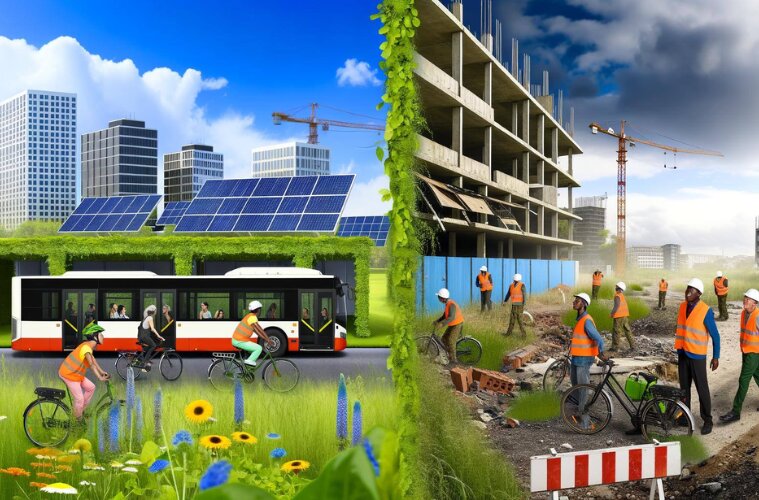Marybeth Collins
On January 21, 2025, a memorandum from Matthew J. Vaeth, Acting Director of the Office of Management and Budget, and Kevin Hassett, Assistant to the President for Economic Policy, outlined the implementation of Section 7 of the Executive Order entitled Unleashing American Energy. This directive mandates federal agencies to pause the disbursement of funds appropriated under the Inflation Reduction Act of 2022 and the Infrastructure Investment and Jobs Act (IIJA) for projects potentially conflicting with Section 2’s policy objectives.
What are the infrastructure-specific impacts of this pause, particularly on projects aligned with clean energy and climate resilience initiatives?
Key Provisions of the Memorandum
The memorandum specifies:
Infrastructure Projects Potentially Affected
Electric Vehicle Charging Infrastructure
- Overview: The IIJA allocated $7.5 billion to establish a nationwide network of EV charging stations, focusing on major highways and underserved areas.
- Impact of Pause: Delays in deploying charging infrastructure could slow the adoption of electric vehicles, undermining efforts to reduce transportation emissions. States relying on federal funding through the National Electric Vehicle Infrastructure (NEVI) Formula Program may experience project setbacks, particularly in rural and low-income regions.
Public Transit Electrification
- Overview: Federal Transit Administration (FTA) funds have been directed toward replacing aging bus fleets with electric or hybrid vehicles and upgrading transit infrastructure to reduce emissions.
- Impact of Pause: Urban areas pursuing low-emission public transit systems, such as Los Angeles’ electric bus initiative, could face funding gaps. These delays risk increasing reliance on older, higher-emission vehicles, reversing progress on clean air initiatives.
Grid Modernization and Resilience
- Overview: Investments in grid infrastructure, including high-voltage transmission lines and energy storage systems, aim to integrate renewable energy sources and improve grid reliability.
- Impact of Pause: Grid modernization projects, particularly those enabling renewable energy integration, may stall. This could limit states’ ability to meet renewable energy targets and hinder resilience against extreme weather events.
Renewable Energy Infrastructure
- Overview: IIJA and Inflation Reduction Act funds have supported the installation of renewable energy systems, such as solar arrays and wind turbines, at public facilities and government buildings.
- Impact of Pause: Federal buildings and facilities, including military bases and national parks, may delay renewable energy projects designed to lower operational costs and reduce carbon footprints.
Broadband Expansion for Climate Monitoring
- Overview: Broadband infrastructure projects funded under the IIJA aim to improve rural connectivity and support climate monitoring systems.
- Impact of Pause: Communities relying on broadband for smart grid technology and environmental data collection could face delays, potentially hampering climate adaptation efforts.
Broader Implications for Infrastructure Development
State and Local Government Challenges
State and local governments heavily reliant on federal funding to meet infrastructure and sustainability goals face significant planning challenges. Projects may require restructuring or delay, increasing costs and eroding public trust.
Private Sector Uncertainty
Private contractors and companies engaged in federally funded infrastructure projects, such as EV charging station installation or grid upgrades, could encounter cash flow disruptions. This uncertainty may deter private investment in long-term sustainability projects.
Policy Alignment and Project Reassessment
Federal agencies must now evaluate whether existing projects align with Section 2 of the Executive Order. This reassessment process could result in substantial delays as agencies navigate new policy interpretations and seek OMB guidance.
Is the Green New Deal Dead?
The memorandum halting funding for infrastructure projects aligned with “Green New Deal” objectives introduces substantial challenges for developing clean energy and climate-resilient infrastructure. Key initiatives in electric vehicle infrastructure, public transit electrification, and grid modernization are particularly vulnerable. While the directive provides agencies with some discretion to resume funding, the delays and uncertainties it introduces may hinder progress toward national infrastructure modernization and climate goals.
As federal agencies and stakeholders adapt to this new guidance, the broader implications for sustainable infrastructure development remain a critical area for observation and analysis. Policymakers and industry leaders must collaborate to ensure that these projects, vital for long-term resilience and sustainability, can move forward effectively.

